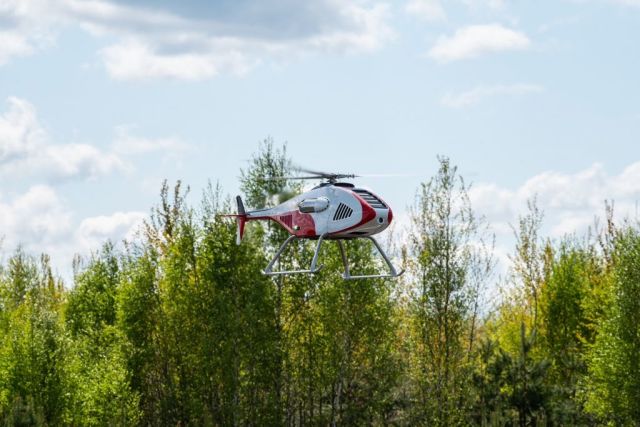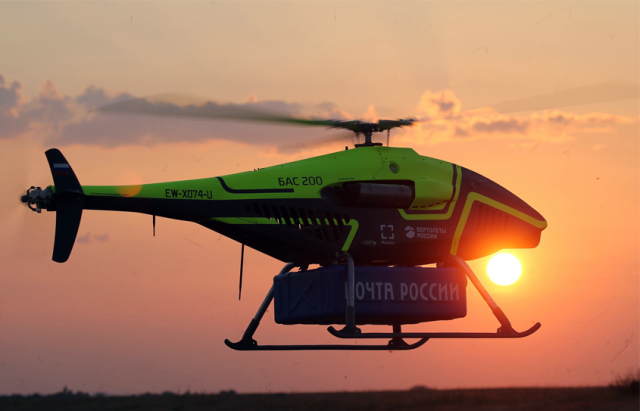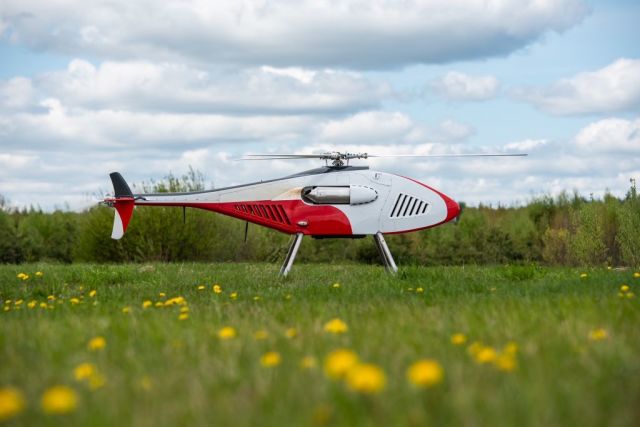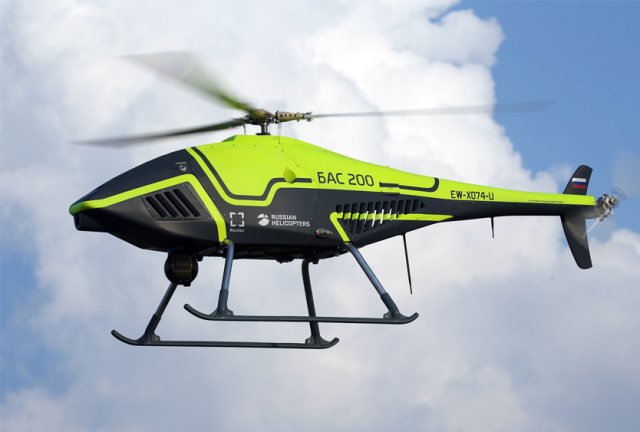Photo: "Russian Helicopters" The UAV of the BAS-200 helicopter type was first presented at the MAKS air show last year, and the other day the complex started certification flight tests. The type certificate for the BAS-200 is planned to be received this year.
Helicopter-type drones, such as the BAS-200, can master many professions. Now the BAS-200 is preparing for test deliveries of parcels together with the Russian Post. We understand what the advantages of this type of machines are, and what the BAS-200 unmanned helicopter is capable of.
Advantages of vertical takeoff
Unmanned aerial vehicles (UAVs) are becoming more common every year. The advantages of drones are obvious. Firstly, the low cost of flight means less spending on fuel, maintenance and training of flight (operator) personnel. A small take-off weight makes it much easier and faster to prepare the device for departure, no runway is needed. Well, and, perhaps, the most important plus – when working in dangerous conditions, nothing threatens the lives of pilots.
Drones continue to evolve and improve, there is a wide variety of schemes and layouts. Perhaps the most popular is the division of UAVs by design and method of flight – into aircraft and helicopter-type systems. Moreover, according to experts, the number of helicopter-type drones has been gradually increasing in the world lately.

The advantage of rotary-wing drones over classic aircraft can be compared with the advantages of helicopters themselves over airplanes. The main feature of helicopters, including unmanned ones, is the ability to take off vertically from any place – unprepared sites, in hard-to-reach terrain, and even from transport. Landing also does not require a large, specially equipped space. In addition, the helicopter drone has a more wind-resistant design, which significantly expands the time range of possible use of the aircraft
The next advantage is the ability to reduce the speed during the flight to almost zero, including hovering mode. In some situations, the ability to "hang out" and study a certain area in detail is simply irreplaceable. For example, when monitoring the terrain, performing reconnaissance.
Heavy helicopter-type UAVs, such as the BAS-200, are capable of lifting significantly heavier loads into the air compared to multicopters, without conceding, and even multiplying the duration of the flight.
Due to the high payload capacity (50 kg) of unmanned aircraft in its class, the BAS-200 is suitable for solving a wide range of tasks: monitoring the terrain during daylight and dark hours, cargo transportation, aerial gravimetric survey, search and rescue operations, laser scanning, magnetometric and thermal imaging, and also has the ability to broadcast information in real time time.
New professions for the BAS-200
The BAS-200 is planned to be used for geophysical exploration, including in hard-to-reach regions of the Arctic zone. Due to its unpretentiousness in operation, mobility and autonomy, one of the most promising applications of the BAS-200 is geological exploration, search for new oil and gas fields.
The pilot project for the BAS-200 is cargo delivery for the Russian Post. The agreement on this was concluded at the MAKS-2021 air show. Already in the summer, the first commercial mail transportation is planned in Chukotka.
There are many hard-to-reach regions in Russia where unmanned aircraft will be able to speed up delivery times by almost half. Next in line are such remote regions as Kamchatka Krai, Yamalo–Nenets and Khanty-Mansi Autonomous Okrugs. According to the estimates of the Russian Post, the use of helicopter-type drones will increase the volume of cargo traffic tenfold and at the same time reduce the cost of transportation by almost two times. Indeed, it is unprofitable to lift manned aircraft into the air or use road transport when fast cargo transportation within a few tens of kilograms is required.

In December 2021, together with the specialists of the Aerogeophysics Research and Development Center, the newest geophysical exploration complex weighing 31 kg was installed on the BAS-200. And then the tests on aerogravimetry were successfully carried out. There are still a number of flights ahead with a number of customers for conducting aerogravimetric and aeromagnetic surveys, monitoring objects.
Currently, the BAS-200 regularly performs test flights for various customers with a wide range of commercial loads and proves in practice that unmanned aviation has a great future.
What is the BAS-200
The BAS-200 is designed according to the classic single-screw scheme with a steering screw, equipped with a rotary piston engine with a maximum power of 54 horsepower.
It is designed to fly in automatic mode for up to 4 hours with a load of up to 50 kilograms. Due to the high load capacity, it is possible to install a wide range of equipment for monitoring and aerial photography. The drone can perform flight tasks at a distance of up to 430 kilometers with a full load.

The development of the BAS-200 project and the flight tests of the drone are carried out by the National Helicopter Building Center "Miles and Kamov" of the Russian Helicopters holding. Recall that for the first time the developers presented their new project at MAKS-2021. The car became the first ever unmanned participant in the flight program of the air show, having flown in automatic mode.
By February 2022, three prototypes of the BAS-200 complex were ready, and in April it was announced that their production and acceptance tests had been successfully completed. All prototypes were transferred to the flight research center "NCV Miles and Kamov" for certification tests. In total, about 90 flights should take place, which are planned to be completed in the second half of the year, that is, already in 2022, the BAS-200 can receive a type certificate, which will allow it to begin serial production.
Specifications
Maximum take–off weight - 200 kg
Commercial load weight – 50 kg
The maximum flight range is up to 430 km
Maximum speed – up to 160 km/h
Flight duration -4 hours
Practical ceiling – up to 3500 m
Data transmission distance via radio communication channel – up to 100 km
The range of the communication channel is 100 km
Standard fuel capacity – 57 liters
Operating temperature range – -30...+45C

